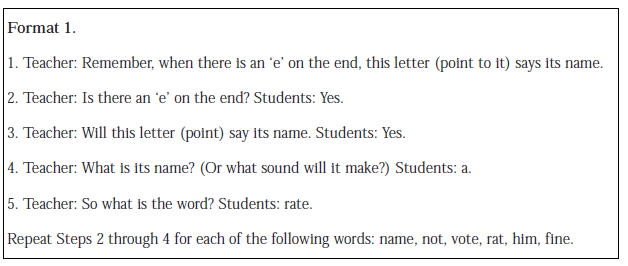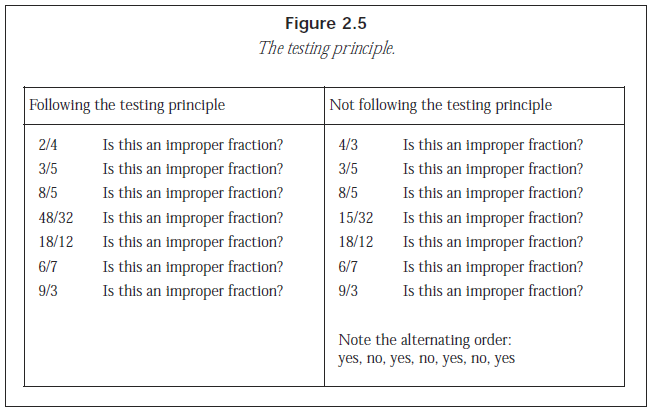This is the seventh post looking at how ideas from Engelmann’s DI can be applied to the everyday classroom. The first six can be found here: one, two, three, four, five, six
Like the last post, this one will examine The Components of Direct Instruction by Cathy L. Watkins and Timothy A. Slocum, an article from The Journal Of Direct Instruction and an extract from Introduction to Direct Instruction. The paper can be found here: https://www.nifdi.org/research/journal-of-di/volume-3-no-2-summer-2003/449-the-components-of-direct-instruction/file
Instructional Formats
Once you have decided upon what you will teach (choosing high utility, generalizable concepts that allow students to ‘further develop their expertise’ in a subject), and have devised sequences of clear communication, the next step is to decide upon the instructional format which ‘specifies the way that teachers will present each example, explanations that they will give, questions that they will ask, and corrections that they will use’. Broadly, teaching should be massively structured, explicit and supported at the beginning in order to ‘ensure a high level of success when strategies are initially introduced’. As student proficiency increases, this support will be faded out ‘so that students learn to apply the skills independently’, preventing them from becoming reliant on teacher assistance. Sequences of learning and practice should move along a continuum from restricted to freer practice, the intention being that student understanding moves from being inflexible to flexible.
Lets have a look at an example from the article which uses these items:

If students were learning to read ‘VCe’ words like the ones in the table above (words that, due to the addition of an ‘e’ at the end, cause a long vowel sound) and were trying to discriminate these from ‘VC’ words like rat and not where the vowel sound is short, then an initial, highly supported instructional sequence may look like this:

Detailed and explicit, the sequence breaks what seems initially to be a simplistic concept into five logical, sequential steps. Each step potentially provides accurate information to the teachers not only about whether a student is proficient, but if they are not, what specific remedial work or additional teaching that may be required in order to address their lack of understanding. If a student fails step 2, perhaps they cannot recognise or do not understand the concept of ‘e’ and may require more practice distinguishing between letters of the alphabet. If students are correct on step 2, but incorrect on step 3, perhaps they require more practice with learning and saying the rule that is explained in step 1.
Later on in a sequence of learning, instructional formats may look like this:

Compared to format 1, these are far less detailed and involve far fewer steps, the assumption being that students are proficient enough to cope with reduced teacher support and instruction.
How does this apply to the everyday classroom?
Following this idea, I wrote here about how items that are taught should move from narrow to wider tasks, probably beginning with massed practice and moving towards spaced practice where students are increasingly expected to apply the knowledge in wider, less structured applications like paragraphs and essays.
Here is an example from teaching students to select and punctuate quotations (the assumption being that this is a new skill that they currently cannot do properly):
Format 1: (heavily supported and broken into sequential steps)
Text extract from Telephone Conversation by Wole Soyinka (a poem from a year 7 unit).
“ARE YOU DARK? OR VERY LIGHT?” Revelation came.
“You mean–like plain or milk chocolate?”
Her accent was clinical, crushing in its light
Impersonality. Rapidly, wave-length adjusted,
I chose. “West African sepia”–and as afterthought,
“Down in my passport.” Silence for spectroscopic
Flight of fancy, till truthfulness clanged her accent
Hard on the mouthpiece. “WHAT’S THAT?”
Instructional Format:
1) Teacher: Here’s a rule: evidence should start and end with quotation marks.
2) Teacher: what’s the rule? Students: evidence should start and end with quotation marks.
2) Teacher: In the last line, underline the words that tell us that the landlady doesn’t understand what the poet is saying.
3) Teacher: say the words Students: WHAT’S THAT?’
4) Teacher: Did she say something or ask something? Students: Ask something
5) Teacher: How do you know? Students: There’s a question mark
6) Teacher: This is how you start: The Landlady asks QUOTATION MARKS
7) Teacher: what comes after the quotation marks? Students: What’s that?
9) Teacher: What is the rule about quotation marks? Students: evidence should start and end with quotation marks.
8) Teacher: what comes after the last word? Students: quotation marks
9) Teacher: How do you know? Students: because evidence should start and end with quotation marks.
Although this sequence is imperfect and certainly violates some of Engelmann’s rigorous principles, I have included it to demonstrate the necessity of breaking down communications into logical, sequential steps as well as to highlight the importance of explicit, teacher directed instruction in the early stage of a sequence of learning. The use of evidence seems like a simple skill to an expert, but it actually requires multiple tiny steps. Each step, in the absence of explicit teaching, guidance and support, is a potential source of confusion and a hindrance for a novice student.
Like the examples from the article, later instructional formats would gradually fade out some if not all of the steps within the earlier sequence, making the process less overt, eventually resulting in the expectation that students apply this important skill in extended writing without any teacher direction or support at all.
As experts we are prone to expert induced blindness: it is hard for us to remember that the processes, skills and abilities which we have automatized to the point of accurate and effortless fluency contain multiple steps which require explicit teaching if students are to reach a similar level of proficiency. Engelmann talks about the idea of dysteachia, the notion that student failure is almost always the result of ineffective teaching, and I think that many students struggle because we often fail to see just how far we need to break a process or concept down when teaching. I will explore this idea more in the next post.
The goal is that ‘by the completion of the instructional program the students’ performance is independent, widely generalized, and applied to various contexts and situations.’ What students could only initially achieve with massive and detailed support, they should eventually be able to do independently, making adaptations and generalisations and succeeding across a range of different and novel problem scenarios.
Next post: Insights from DI part 8: The 6 ‘shifts’ of task design





 In the left hand column, the non-example is a gerund phrase (the subject of the verb ‘was’). Gerund phrases are often confused with participle phrases and the juxtaposition of these two examples demonstrates why that is: they are incredibly similar. The non-example here is helpful as it gives precise information as to the delineation between ‘present participle’ and ‘not present participle’. In the right hand column, the non-example is massively different, making it harder for a student to ascertain the boundaries of the concept being taught.
In the left hand column, the non-example is a gerund phrase (the subject of the verb ‘was’). Gerund phrases are often confused with participle phrases and the juxtaposition of these two examples demonstrates why that is: they are incredibly similar. The non-example here is helpful as it gives precise information as to the delineation between ‘present participle’ and ‘not present participle’. In the right hand column, the non-example is massively different, making it harder for a student to ascertain the boundaries of the concept being taught.




